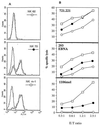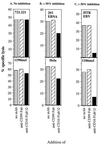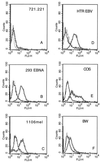Human CD16 as a lysis receptor mediating direct natural killer cell cytotoxicity
- PMID: 10318937
- PMCID: PMC21913
- DOI: 10.1073/pnas.96.10.5640
Human CD16 as a lysis receptor mediating direct natural killer cell cytotoxicity
Abstract
In addition to their role in peptide antigen presentation, class I MHC proteins also play a critical role in inhibiting natural killer (NK) cytotoxicity through interaction with NK inhibitory receptors. Thus, NK cells are cytotoxic to virus-infected and tumor cells that have lost class I MHC protein expression. However, the nature of the receptors involved in the triggering of lysis of target cells is poorly understood. CD16 (Fcgamma receptor III) has been described as a receptor expressed on NK cells that facilitates antibody-dependent cellular cytotoxicity (ADCC) by binding to the Fc portion of various antibodies. However, we show here that CD16 has a broader function and is directly involved in the lysis of some virus-infected cells and tumor cells, independent of antibody binding. The presence of a putative CD16 ligand on appropriate target cells has also been demonstrated by the use of a CD16-Ig fusion protein.
Figures





References
-
- Ljunggren H-G, Karre K. Immunol Today. 1990;11:237–244. - PubMed
-
- Colonna M, Samaridis J. Science. 1995;268:405–408. - PubMed
-
- Wagtmann N, Biassoni R, Cantoni C, Verdiani S, Malnati M S, Vitale M, Bottino C, Moretta L, Moretta A, Long E O. Immunity. 1995;2:439–449. - PubMed
-
- D’Andre A, Chang C, Franz-Bacon K, McClanahan T, Phillips J H, Lanier L L. J Immunol. 1995;155:2306–2310. - PubMed
Publication types
MeSH terms
Substances
Grants and funding
LinkOut - more resources
Full Text Sources
Other Literature Sources
Molecular Biology Databases
Research Materials

